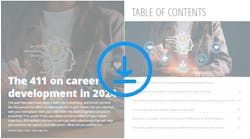The online “classroom” is a convenient way to increase knowledge.
Isn’t technology amazing? Computers, cell phones, fax machines, printers, and much more have changed our lives forever. Did you ever think that, while you are driving on a trip, your child is watching a DVD in the back seat? Education has been dramatically affected by changes in technology. Distance learning, although not new to the educational scene, has become a viable alternative to attending classes at a university campus.
Distance learning is “a formal educational process where the majority of the instruction occurs when the learner and the instructor are not in the same place and are often separated by time.”1 Approximately three million students are taking online classes at higher learning institutions, according to the Sloan Consortium, a source of information about online education. This is clearly a rapidly growing trend that began with the advent of technology.
The advantages of distance learning are numerous. Distance learners are often searching for ways to advance in their jobs, change careers, or increase their knowledge. Many are looking for an alternative to the traditional campus due to family commitments, and many live far from any university campus. People with physical limitations can earn degrees from the comfort of their homes.
Students find distance learning convenient, efficient, and useful. Due to the asynchronous nature of distance learning, students can attend classes 24 hours a day, seven days a week, and study at their own pace. Each program has specific requirements regarding the number of times a student must post to a class, usually several times a week. The online environment acts as a social equalizer, where prejudices based on appearance, sex, and race are unable to exist.1 Commuting and parking are not problems, and there is no need to hire a babysitter.
A drawback to distance learning is the lack of face-to-face interaction. Online communication can lead to miscommunication. Most universities emphasize the need for courtesy and professionalism when posting in the virtual classroom. Students can also connect with classmates through phone conferences, chat rooms, and e-mails. Some universities have residency requirements, during which students meet for classes at the traditional campus prior to, during, or following the program.
A 2005 study by Payne and Johnson examined tips from successful online graduate students, and revealed that most participants feel the quality of online courses is equal to that of on-campus courses. Participants commented on the quick responses to questions by professors. One participant said it was advantageous to have high-quality faculty members with diverse experience.2
The profile of a distance learner is often different from that of the traditional student. Although many students ages 18 to 22 are discovering the benefits of distance learning, distance learners are generally older than those who attend a traditional campus. Many have some college experience, and are highly motivated and self-disciplined. Women account for more than half of the distance learners, and many programs have international students enrolled.
In order to prepare for class, distance learners need a computer, modem or connection to the Internet, printer, and ISP. The dial-up connection that works well for personal use can be a disadvantage when a student needs to download several articles quickly, so broadband is suggested. Classes prior to enrollment, such as Microsoft Word or Microsoft Office, are helpful. Many universities provide academic advisors and technical support personnel to assist students in setting up their classrooms online.
Required textbooks are posted online each semester. Students can order from the university bookstore, a textbook Web site, or a well-known bookstore, and the textbooks are delivered to the student’s front door. Some universities offer books that can be read online or printed from the computer.
Also, distance learning is writing-intensive. Students should be prepared to conduct research and share findings with their classmates.
Distance learners can earn associate’s, bachelor’s, master’s, and doctoral degrees, or take continuing education or certificate courses. Many online universities handle applications and transcript requests online. Degrees are offered in dental hygiene (bachelor’s degree), nursing, law, psychology, and much more.
Although there are too many distance learning programs to mention in detail (see related sidebar), there are some important points to look for when searching for a program:
• Is the school accredited and by whom? Accreditation is the “assurance you will be able to attain the same educational outcomes as you would in traditional classroom-based programs”.1
The six regional accreditation associations are New England Association of Schools and Colleges, Middle States Association of Colleges and Schools, North Central Association of Colleges and Schools, Northwest Association of Schools and Colleges, Southern Association of Colleges and Schools, and Western Association of Schools and Colleges.
• How many students are enrolled in the program? The more students enrolled, the more experienced the program.
• How many students graduate each year? You want to know if the rate of attrition is fairly low.
• How long has the program been offered online? Once again, you are looking for a school with a proven track record.
• Is technical support available 24/7? For a new online student, this is important. Technical support can “walk you through” most difficulties with your computer.
Distance learning may not be for everyone. The only true way to discover whether it works for you is to take a course online. Technology has enabled distance learning to become an alternative to traditional classroom learning. Take advantage of what technology has to offer and further your education ... the online way.
Maggie Vivoda, RDH, MBA, is the CEO of Dental Concepts Consulting Services. She has been a registered dental hygienist for 26 years and is working toward a doctorate of management in organizational leadership. Ms. Vivoda can be reached at [email protected].
References
1 Criscito P. (2002) Barron’s guide to distance learning: the practical guide to standard classroom training. 2nd edition. New York: Barron’s Educational Series, Inc.
2 Payne DA, Johnson JM. (2005) Succeeding in graduate school online: Tips from successful students. College Student Journal (39) 1. p. 117-129.
3 Helm M, Helm A. (2000) Get your degree online. New York: McGraw-Hill.
Time management in the online world
The effective use of time is critical to the distance learner. After interviewing distance learners, the College Student Journal offers these suggestions:2
• Use the syllabus and a planner to sketch out the semester.
• Organize and prioritize tasks.
• Plan homework time around a work schedule if necessary.
• Study at an office or library to avoid distractions at home.
• Study after children go to bed.
• Work on assignments several days before they are due. If there are any problems, students have time to contact the professor with questions.
• Be disciplined, read the online discussions, and do some work each day.
Examples of online programs
A considerable number of online programs are offered in the United States. Many colleges that offer traditional on-campus programs now offer distance learning. Some well-known universities that offer distance learning are Nova Southeastern University, University of Phoenix, and Capella University. Here is a brief overview of their programs.
Nova Southeastern University has been a leader in distance learning since 1983. It pioneered online graduate education with its UNIX-based network 22 years ago. “Forbes and the Wall Street Journal have recognized Nova Southeastern University as one of the top universities offering distance learning programs.”1
■ University of Phoenix is the nation’s largest private accredited university and a leader in online education since 1989. UOP has 17,000 instructors at 179 campuses in the United States, Puerto Rico, and Canada. Instructors are required to have either a master’s degree or doctoral degree.
■ Capella University’s program was founded in 1993. As of February 2004, the university, which is based in Minneapolis, had 10,000 distance learners. It offers over 400 online courses and 80 specialized degree programs.





